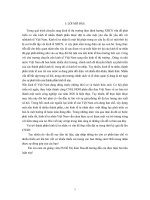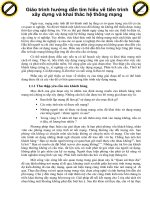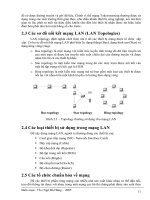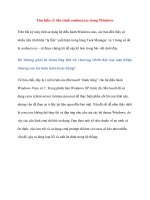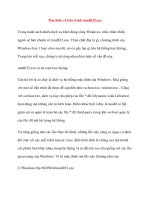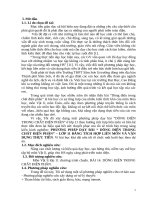Bài tập điền từ và đọc hiểu trong tiếng anh (có đáp án)
Bạn đang xem bản rút gọn của tài liệu. Xem và tải ngay bản đầy đủ của tài liệu tại đây (368.04 KB, 5 trang )
CHUYÊN ĐỀ BT ĐIỀN TỪ + ĐỌC HIỂU (Ngày 07/01/2017) | (Biên soạn)
CHUYÊN ĐỀ BÀI TẬP ĐIỀN TỪ + ĐỌC HIỂU
(Ngày 07/01/2017)
Read the following passage and mark the letter A, B, C, or D on your answer sheet
to indicate the correct word or phrase that best fits each of the numbered blanks
from 1 to 10.
TRAFFIC LIGHTS
The first traffic signal was invented by a railway signaling engineer. It was
installed (1)_____ the Houses of Parliament in 1868. It (2)_____ like any railway signal
of the time, and was operated by gas. (3)_____, it exploded and killed a policeman, and
the accident discouraged further development until cars became common.
(4)_____ traffic lights are an American invention. Red – green systems were
installed in Cleveland in 1914. Three - color signals, operated (5)_____ hand from a
tower in the (6)_____ of the street, were installed in New York in 1918. The first lights
of this type to (7)_____ in Britain were in London, on the junction between St. James’s
Street and Piccadilly, in 1925. Automatic signals were installed (8)_____ year later.
In the past, traffic lights were special. In New York, some lights had a statue on
top. In Los Angeles the lights did not just change silently, but would ring bells to
(9)_____ the sleeping motorists of the 1930s. These are gone and have been (10) _____
by standard models which are universally adopted.
Question 1: A. outside
B. out
C. out of
D. outdoors
Question 2: A. resembled
B. looked
C. showed
D. seemed
Question 3: A. However
B. Therefore
C. Although
D. Despite
Question 4: A. New
B. Recent
C. Modern
D. Late
Question 5: A. by
B. with
C. through
D. in
Question 6: A. middle
B. heart
C. focus
D. halfway
Question 7: A. show
B. appear
C. happen
D. become
Question 8: A. a
B. in the
C. in a
D. the
Question 9: A. rise
B. raise
C. wake
D. get up
Question 10: A. reproduced
B. replaced
C. removed
D. remained
Read the following passage and mark the letter A, B, C, or D on your answer sheet
to indicate the correct answer to each of the questions from 11 to 20.
Human Nutrition is the study of how food affects the health and survival of the
human body. Human beings require food to grow, reproduce, and maintain good health.
Without food, our bodies could not stay warm, build or repair tissue, or maintain the
heartbeat. Eating the right foods can help us avoid certain diseases or recover faster
when illness occurs. These and other important functions are fueled by chemical
CHUYÊN ĐỀ BT ĐIỀN TỪ + ĐỌC HIỂU (Ngày 07/01/2017) | (Biên soạn)
substances in our food called nutrients. Nutrients are classified as carbohydrates,
proteins, fats, vitamins, minerals, and water.
When we eat a meal, nutrients are released from food through digestion.
Digestion begins in the mouth by the action of chewing and the chemical activity of
saliva, a watery fluid that contains enzymes, certain proteins that help break down food.
Further digestion occurs as food travels through the stomach and the small intestine,
where digestive enzymes and acids liquefy food and muscle contractions push it along
the digestive tract. Nutrients are absorbed from the inside of the small intestine into the
bloodstream and carried to the sites in the body where they are needed. At these sites,
several chemical reactions occur, which ensures the growth and function of body tissues.
The parts of foods that are not absorbed continue to move down the intestinal tract and
are eliminated from the body as feces.
Once digested, carbohydrates, proteins, and fats provide the body with the energy
it needs to maintain its many functions. Scientists measure this energy in kilocalories,
the amount of energy needed to raise one kilogram of water one degree Celsius. In
nutrition discussions, scientists use the term calorie instead of kilocalorie as the standard
unit of measure in nutrition.
Nutrients are classified as essential or nonessential. Nonessential nutrients are
manufactured in the body and do not need to be obtained from food. Examples include
cholesterol, a fatlike substance present in all animal cells. Essential nutrients must be
obtained from food sources, because the body either does not produce them or produces
them in amounts too small to maintain growth and health. Essential nutrients include
water, carbohydrates, proteins, fats, vitamins, and minerals.
An individual needs varying amounts of each essential nutrient, depending upon
such factors as gender and age. Specific health conditions, such as pregnancy, breastfeeding, illness, or drug use, make unusual demands on the body and increase its need
for nutrients. Dietary guidelines, which take many of these factors into account, provide
general guidance in meeting daily nutritional needs.
From “Human Nutrition” by Worthington-Roberts, Bonnie, Microsoft ® Student 2009.
Question 11: The first paragraph mainly discusses _____.
A. chemical substances in our food
B. a variety of essential nutrients to human beings
C. the importance of food to human beings
D. the study of human nutrition
Question 12: The word “released” in the second paragraph mostly means _____.
A. refused
B. produced
C. expressed
D. renewed
Question 13: Which of the following is NOT true about the process of digestion?
CHUYÊN ĐỀ BT ĐIỀN TỪ + ĐỌC HIỂU (Ngày 07/01/2017) | (Biên soạn)
A. The small intestine covers the whole digestive system.
B. The small intestine helps the body absorb nutrients.
C. Nutrients are carried to different sites in the body
D. Saliva plays an important role in the first stage of digestion
Question 14: The word “maintain” in the paragraph is closest meaning to _____.
A. obtain
B. provide
C. keep performing
D. carry on making
Question 15: According to the passage, nutrients are absorbed _____.
A. over the whole body
B. in the mouth
C. in the stomach
D. in the small intestine
Question 16: According to the passage, which of the following provides energy for the
body?
A. Proteins, fats, and minerals
B. Carbohydrates, proteins, and fats
C. Carbohydrates, minerals, and water
D. Proteins, vitamins, and carbohydrates
Question 17: In nutrition discussions, the standard unit used to measure nutrients is
_____.
A. kilocalorie
B. kilogram
C. calorie
D. gram
Question 18: The word “which” in the last paragraph refers to _____.
A. general guidance
B. unusual demands
C. dietary guidelines
D. nutritional needs
Question 19: Which of the following is NOT mentioned in the passage?
A. Classification of nutrients
B. The body’s need of nutrients
C. The effects of food on the body
D. Food sources from animals
Question 20: Through the passage, the author provides the readers with _____.
A. instructions
B. some information
C. some proposal
D. orders
Read the following passage and mark the letter A, B, C, or D on your answer sheet
to indicate the correct answer to each of the questions from 21 to 30.
Very few people in the modern world obtain their food supply by hunting and
gathering in the natural environment surrounding their homes. This method of
harvesting from nature's provision is the oldest known subsistence strategy and has been
practised for at least the last two million years. It was, indeed, the only way to obtain
CHUYÊN ĐỀ BT ĐIỀN TỪ + ĐỌC HIỂU (Ngày 07/01/2017) | (Biên soạn)
food until rudimentary farming and the domestication of wild animals were introduced
about 10,000 years ago.
Because hunter-gatherers have fared poorly in comparison with their agricultural
cousins, their numbers have dwindled, and they have been forced to live in marginal
environments, such as deserts and arctic wastelands. In higher latitudes, the shorter
growing seasons have restricted the availability of plant life. Such conditions have
caused a greater dependence on hunting, and on fishing along the coasts and waterways.
The abundance of vegetation in the lower latitudes of the tropics, on the other hand, has
provided a greater opportunity for gathering a variety of plants. In short, the
environmental differences have restricted the diet and have limited possibilities for the
development of subsistence societies.
Contemporary hunter-gatherers may help us understand our prehistoric ancestors.
We know from the observation of modern hunter-gatherers in both Africa and Alaska
that a society based on hunting and gathering must be very mobile. While the entire
community camps in a central location, a smaller party harvests the food within a
reasonable distance from the camp. When the food in the area has become exhausted,
the community moves on to exploit another site. We also notice seasonal migration
patterns evolving for most hunter-gatherers, along with a strict division of labor between
the sexes. These patterns of behavior may be similar to those practised by mankind
during the Paleolithic Period.
Question 21: A typical feature of both modern and prehistoric hunter-gatherers is that
_____.
A. they don't have a healthy and balanced diet
B. they live in the forests for all their life
C. they don't have a strong sense of community
D. they often change their living places
Question 22: The word “marginal” in the second paragraph is closest in meaning to
_____.
A. suburban
B. disadvantaged C. forgotten
D. abandoned
Question 23: According to the passage, studies of contemporary subsistence societies
can provide a _____.
A. deeper insight into the dry-land farming
B. further understanding of modern subsistence societies
C. broader vision of prehistoric natural environments
D. further understanding of prehistoric times
Question 24: According to the passage, subsistence societies depend mainly on _____.
CHUYÊN ĐỀ BT ĐIỀN TỪ + ĐỌC HIỂU (Ngày 07/01/2017) | (Biên soạn)
A. agricultural products
B. nature's provision
C. farming methods
D. hunter-gatherers' tools
Question 25: According to the author, most contemporary and prehistoric huntergatherers share _____.
A. only the way of duty division
B. some restricted daily rules
C. some methods of production
D. some patterns of behavior
Question 26: Which of the following would serve as the best title of the passage?
A. Hunter-gatherers: Always on the Move
B. Evolution of Humans' Farming Methods
C. Hunter-gatherers and Subsistence Societies
D. A Brief History of Subsistence Farming
Question 27: In the lower latitudes of the tropics, hunter- gatherers _____.
A. have better food gathering from nature
B. live along the coasts and waterways for fishing
C. harvest shorter seasonal crops
D. can free themselves from hunting
Question 28: According to the passage, which of the following is NOT mentioned?
A. The environmental differences produce no effect on subsistence societies.
B. Hunting or fishing develops where there are no or short growing seasons.
C. The number of hunter-gatherers decreases where farming is convenient.
D. Harvesting from the natural environment had existed long before farming was
taken up.
Question 29: The word “conditions” in the second paragraph refers to _____.
A. the situations in which hunter-gatherers hardly find anything to eat
B. the places where plenty of animals and fish can be found
C. the environments where it is not favorable for vegetation to grow
D. the situations in which hunter-gatherers can grow some crops
Question 30: The word “domestication” in the first paragraph mostly means _____.
A. making wild animals used to living with and working for humans
B. adapting animals to suit a new working environment
C. hatching and raising new species of wild animals in the home
D. teaching animals to do a particular job or activity in the home
